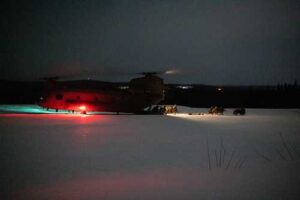 To the greater Alaska community,
To the greater Alaska community,
It may be summer here, but interest in the Arctic never stops.
Last week, Joint Base Elmendorf-Richardson hosted the biennial Arctic Thunder Open House. If you’re one of the thousands who made it out, you got a look at what’s “behind the fence” and witnessed some of the military capabilities that are based here in Alaska.
In the days after the Open House, the Arctic and Alaska were in the headlines with the Department of Defense’s public release of their 2024 Arctic Strategy, and a joint Chinese and Russian bomber patrol flying about 200 miles off the Alaskan coast.
While the timing was coincidental, Alaska, and the DOD’s Arctic Strategy, has never been more important.
The Arctic is a competitive space. This week’s joint Russian – Chinese bomber patrol was not the first time the Russians or the Chinese have encroached on our national interests in the Arctic; but it’s the first time they’ve done it together.
The 2024 DOD strategy is an important update that brings an increased level of detail to the department’s previous strategy for the Arctic, supporting the National Strategy for the Arctic Region, published in 2022, and the U.S. aim that the Arctic is peaceful, stable, prosperous, and cooperative.
The forces stationed here in Alaska defend the northern-most reaches of the U.S, and are assigned to U.S. INDOPACIFIC Command, an area representing more than 50% of the world’s population that sees most of the world’s maritime trade moving through its waters.
The Indo-Pacific, which includes Alaska, is the Department’s priority theater and its focus is the nation’s greatest strategic competitor – China.
And since our reactivation in 2022, the 11th Airborne Division, along with units stationed across the state have been at the forefront of the strategy.
While the Army’s contribution is most visible during our Joint Pacific Multinational Readiness Center – Alaska rotations, that’s not the whole story. That exercise, conducted in the heart of winter in some of the most extreme conditions on Earth, doesn’t just test the mettle of our Arctic Angels, it serves as a proving ground and a living laboratory.
It’s the ultimate showcase of the results of daily training, and what’s earned from living and working here. We’ve used knowledge gained from our Alaska Native partners and technological innovations from across industry to test emerging technologies and innovate solutions to warfighting at 50 below zero, examples of the strong community ties built in Alaska.
Along with the Northern Warfare Training Center, Black Rapids Training Site and our specialty training conducted here, this makes us able to survive and thrive in the Arctic, building the readiness that is the foundation of the DOD’s Arctic Strategy.
And what we learn here, doesn’t stay here. We constantly train alongside allies and partners in the Indo-Pacific and across the globe, sharing hard-earned lessons, building the proficiency and allied capability needed for deterrence throughout the region. It’s not just the skill sets, but the relationships built during those exercises that are the catalysts for successful multinational operations in the Arctic and cold weather regions.
Preparedness to protect our local and national interests has always rested on a global joint force, but for those of us who are stationed here in this strategic region, that preparedness is not conceptual. It’s built on training, living and working in this environment, the strength of our local communities, and your continued support of our soldiers and families.
Whether we’re supporting our allies and partners in the Pacific, at exercises and training events at home or across the globe, or working to thrive in the incredible state we all call home, the 11th Airborne Division continues to be the leading edge of the Arctic Strategy. We cannot afford not to be.
Maj. Gen. Joseph E. Hilbert,
11th Airborne Division Commanding General
